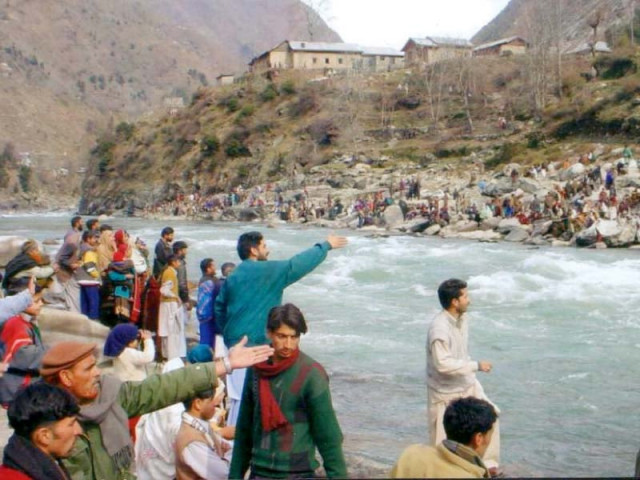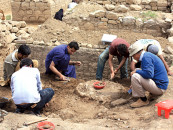Kashmir: Shedding barriers by the riverside
Waters of River Neelum at Keran, not fences or manmade borders, are the only divide between Kashmiris on both sides.

The waters of River Neelum at Keran, not fences or manmade borders, are the only divide between Kashmiris on both sides. LAYOUT: AMNA IQBAL
From September to February, as the Neelum River’s water level decreases at Keran, the banks play host to uniting spectacle like no other. Kashmiris stand on either side – one side Indian occupied, the other Pakistani – separated just by the clear, blue, running water. Families and loved ones, divided by discourses on nation and identity, tie gifts and letter to stones and fling them across the river to express oneness with each another.
This, indeed, is the stuff movies are made of.
One people
The Neelum River, flowing through the lush green mountains of the valley, has been dividing the people of the Jammu and Kashmir since 1947. It flows from Taubutt, enters Azad Kashmir from Indian-occupied Kashmir, and stealthily splits the land of saints at various places before merging into the Jhelum near Domail, Muzaffarabad. In this manner, the river serves as a natural line of control.

At Keran, families from both sides can be observed waving to each other, fetching water, and even talking. And yet, they cannot meet. Besides the movement of civilians, Indian troops can also be easily observed.
“I have been a regular visitor of Keran for the last five years. My forefathers were from Srinagar,” says Fida Dar, a businessman from Islamabad, his eyes full of tears. “I have never been able to meet my relatives, as my grandfather emigrated from Srinagar in 1947. I want to remain in touch with his land, with my land. That is why I stay here for two to three nights every now and then.”
Fida is still haunted by the last minutes of his grandfather’s life. The older Dar passed away muttering ‘Kashmir, Kashmir’ over and over again.
No fences, just water in between
Keran, with its famous bank of the Neelum, 1,500 metres above sea level, from where Indian occupied Kashmir can easily be observed, has fast become a famous tourist spot. There is no fence, no watchtower to be observed on either side – the river is the only separator.
“People are abusing Pervez Musharraf left and right but we, the residents of Neelum Valley, salute him,” says a local journalist. “The present influx of tourists is the outcome of the ceasefire with India, announced by Musharraf in 2003.”

Today, business for the many guest houses is doing well.
“Tourists who stay at Keran want to know much more about occupied Kashmir once they observe the Indian troops on the other side,” says Khawaja Awais, the owner of a private guest house. “Some, who have roots on the other side, become emotional and start blaming international organizations such as the United Nations for this division between Kashmiris.”
Everyone’s curious
Last year, it wasn’t just the divided families, tourists and trekkers that frequented Keran. Prime Minister Nawaz Sharif, too, stayed here for a night.
“During his visit, the premier also keenly observed the other side of Kashmir, clearly evident from the river,” recalls Ab Salman Butt, a local Pakistan Muslim League-Nawaz leader in the valley.
Published in The Express Tribune, June 19th, 2013.


















COMMENTS
Comments are moderated and generally will be posted if they are on-topic and not abusive.
For more information, please see our Comments FAQ